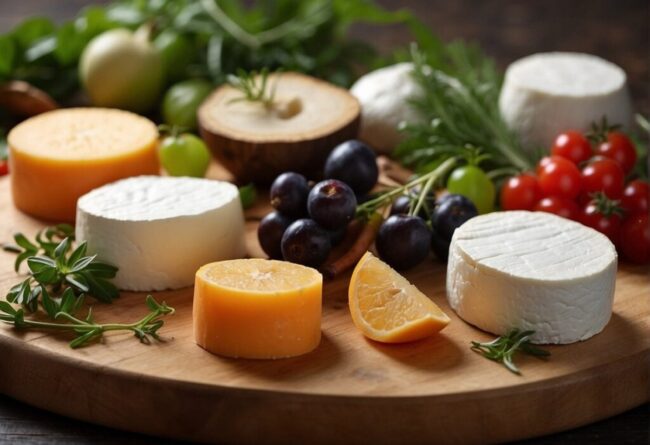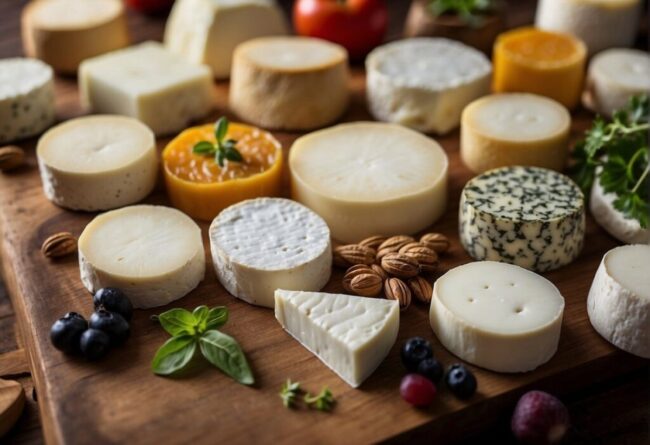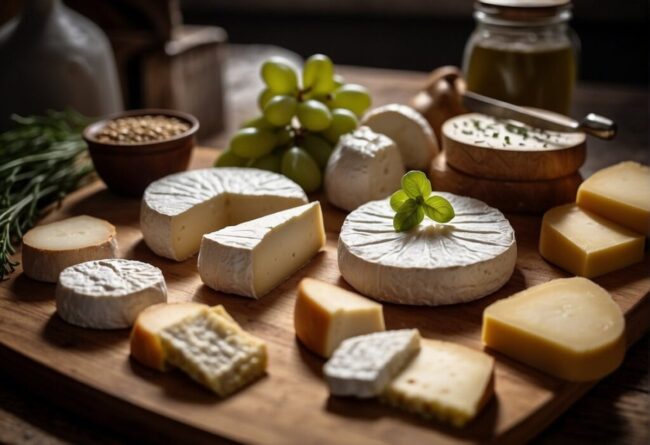5 Rich and Tangy Goat Cheeses to Explore
Types of goat cheese reveal a spectrum of tangy, creamy flavors that transform every culinary experience.
An exploration of these varieties uncovers textures ranging from luxuriously soft to intriguingly crumbly.
Each style contributes a unique twist that elevates salads, spreads, and gourmet dishes.
The diverse profiles enrich recipes with layers of character that surprise and please the palate.
What to Know About Goat Cheese
Goat cheese has a tangy flavor and creamy texture, making it a popular addition to salads, pizzas, and spreads. It comes in soft and aged varieties.
What Is Goat Cheese?
Goat cheese, known as chèvre in France, offers a delightful range of flavors and textures that can elevate any dish.
Its unique tang comes from higher fatty acid levels compared to cow's milk cheeses.
Many people appreciate its digestibility since it contains less lactose, making it a favorite among those with dairy sensitivities.
From the creamy spread of fresh goat cheese to the nutty richness found in aged varieties, there's something for everyone’s palate.
Exploring this versatile ingredient can lead you to new culinary adventures that surprise and satisfy your taste buds.
Cheese Making Essentials
Cheesemaking showcases the transformative journey of liquid milk into a variety of cheese forms.
Each step in this process plays a crucial role, starting with pasteurization to ensure safety while unlocking unique flavors.
Curds emerge through the addition of cultures and rennet, leading to an exciting separation between solids and liquids.
After curd processing, cheesemakers skillfully manipulate texture by cutting or cooking as needed.
Aging in controlled conditions allows for flavors to deepen and evolve, offering you an incredible range from nutty aged varieties to fresh creamy delights that elevate any meal experience.
Different Kinds of Goat Cheese
Goat cheese captivates with its creamy texture and distinctive flavor. Varieties range from tangy chevre to aged, crumbly options, so keep reading to see what they are.
Chevre (Fresh Goat Cheese)
Chèvre captivates with its creamy texture and bright, citrusy flavor.
This fresh goat cheese is perfect for spreading on crusty bread or pairing with fruits.
Classic chèvre delights the palate with its lemony zest, enhancing any dish it graces.
Varieties like feta bring a crumbly texture along with a salty tang that complements salads beautifully.
Elevate your next meal by incorporating these cheeses; their versatility will surprise you in the best ways.
Types of Aged Goat Cheese
Aged goat cheeses bring a delightful complexity to your palate.
Rich caramel notes in gouda create a luxurious experience, while cheddar surprises with its sharpness and firm texture.
Exploring these varieties opens the door to unique flavor combinations that enhance any dish.
The contrast between sweet and piquant elements makes every bite an adventure in taste.
Discovering aged goat cheeses can elevate your culinary creations, inviting both curiosity and satisfaction at the table.
Creamy Goat Cheeses
Soft-ripened goat cheeses like brie and camembert have a rich, creamy interior that pairs beautifully with their delicate bloomy rinds.
The earthy undertones develop as they mature, offering layers of taste that are hard to resist.
Humboldt fog impresses with its unique layer of ash, adding a visual and flavor complexity that intrigues the palate.
Crottin de Chavignol surprises with its small size and natural rind, revealing nuttier notes as it ages gracefully.
These cheeses invite exploration, whether served on a charcuterie board or enjoyed alongside fresh fruits and artisan breads.
Blue Goat Cheese
Blue goat cheeses capture attention with their distinctive blue or green veins, resulting from Penicillium cultures.
Creamy textures deliver a bold, sharp flavor that appeals to those who appreciate the unique profile of blue cheese.
Valençay stands out with its ashy exterior and tangy notes, offering a delightful contrast in taste and appearance.
Selles-sur-Cher presents an equally intriguing experience; its subtle tang pairs beautifully with the ash rind for added depth.
These cheeses invite exploration and promise to elevate any culinary adventure you embark on.
Semi-Hard and Hard Goat Cheeses
Looking for cheese that holds its shape and offers a delightful taste?
Semi-hard and hard goat cheeses are excellent choices.
With their aging process, these cheeses develop flavors that can surprise your palate with sweetness, nuttiness, or a deeper richness.
Drunken Goat stands out with its wine-cured sweetness and smooth texture; it’s perfect for those who appreciate a gentle touch of flavor.
Garrotxa surprises with an earthy complexity that enhances any cheese board or dish you create.
Goat Cheese in Cooking
Goat cheese works well in cooking, adding richness to pasta, omelets, and sauces. Its bold flavor complements both sweet and savory dishes.
Food Matches and Sides
Goat cheese offers a delightful experience, especially when paired thoughtfully.
Crisp white wines such as Sauvignon Blanc or a light Pinot Noir complement its tangy essence beautifully.
Fresh fruits like apples and figs enhance its flavor, while dried varieties provide an interesting contrast in sweetness.
Salads come alive with the addition of crumbled goat cheese, particularly when dressed with vinaigrettes and sprinkled nuts.
Exploring these combinations can elevate your meals to new heights, inviting you to savor every bite fully.
Using Goat Cheese in Dishes
Introducing goat cheese into your meals can elevate everyday dishes in exciting ways.
Consider a pizza topped with this creamy delight, where sun-dried tomatoes and caramelized onions create a burst of flavor.
Sandwiches become extraordinary when you layer grilled vegetables or roasted meats with goat cheese, adding both richness and depth.
In savory dishes like stuffed chicken or pasta fillings, this ingredient enhances the overall taste beautifully.
Trying out these combinations will surely inspire your culinary adventures and impress anyone at the table!
Types and Origins of Goat Cheese
Different goat cheese varieties range from fresh chèvre to aged gouda-style cheese. Each type has distinct textures and flavor intensities.
Top Goat Cheese Areas
Goat cheese in the United States has evolved impressively, showcasing a range of flavors and textures that rival traditional European varieties.
Producers experiment boldly, often drawing from classic French recipes while incorporating local ingredients.
Catalonia’s Garrotxa stands out with its striking gray rind and earthy taste, reflecting the unique terroir of the Pyrenees region.
In France's Loire Valley, Chevre shines as a symbol of quality; its tangy notes arise from the area's rich soil and ideal climate conditions.
Popular Goat Cheeses by Area
Cheese lovers will appreciate the rich variety found across different regions.
Humboldt Fog offers a creamy texture with an intriguing line of edible ash, balancing tangy and smooth flavors.
In contrast, American Chèvre presents a fresh taste that highlights the delightful characteristics of goat milk in every bite.
Catalonia’s Garrotxa impresses with its semi-firm consistency and herbal undertones that create a nutty experience on the palate.
Loire Valley cheeses like Crottin de Chavignol stand strong alongside local wines, while Valençay showcases soft textures wrapped in ash to honor traditional cheese-making techniques from goat's milk.
How to Store and Choose Goat Cheese
Storing goat cheese properly extends its shelf life and maintains flavor. Wrapping it in wax paper and refrigerating prevents excess moisture buildup.
Choosing Good Goat Cheese
Selecting goat cheese involves exploring flavors that resonate with your palate.
Fresh options offer a light, tangy taste, while aged varieties surprise with deeper, earthy notes.
The rind serves as a visual guide; a bloomy rind points to creaminess and softness, whereas a hard rind reveals age and firmness.
For those who appreciate boldness in flavor, seek out cheeses adorned with salt crystals. They often indicate careful aging processes.
Each choice can enhance your culinary experience in delightful ways that suit any occasion.
Effective Storage Tips
Fresh goat cheese needs a cool spot in your fridge, ideally between 35°F and 40°F.
Proper wrapping is essential; cling film or its original packaging helps keep air out and moisture in.
For aged goat cheese, a slightly warmer area works better, so consider storing it where the temperature isn't as cold.
Wrapping it in parchment paper before adding aluminum foil provides the right balance of protection without suffocating the cheese.
Keeping these cheeses tucked away in your vegetable drawer or on a shelf away from direct airflow allows them to breathe naturally while minimizing mold risk.



